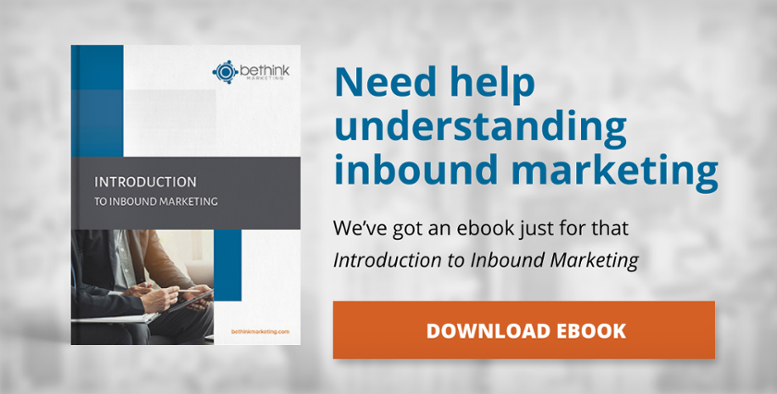
The sales power has shifted dramatically from seller to buyer due to the power of search engines. According to HubSpot, 77% of B2B buyers do not talk with a sales rep until they have done their own research online. In fact, 57% of the buying decision is already done before they even speak with a sales rep. As search engines are becoming more sophisticated and companies start publishing content online, there is no doubt that these numbers will increase. This is why the Consumer's Journey or Buyer's Journey (modern term) is needed.
Knowing that the majority of buyers are doing their own research online, it’s crucial that this fact is taken into consideration. The days where potential customers’ first response is to contact an advisor are becoming uncommon as most will now opt to do their research online to better understand their needs prior to communicating with a company representative.
When applying inbound marketing or any marketing initiatives, understanding the Buyer’s Journey of your Buyer Personas for your firm will help you reach prospects and nurture leads before they speak with one of your sales staff.
What is the Buyer’s Journey?
The Buyer’s Journey states how customers progress from being aware of a challenge that they are facing to the point that they have decided to make a purchase of a solution from 1 supplier that they deem to be the best at helping them.
The Buyer’s Journey has 3-stages: Awareness, Consideration, and Decision.

Awareness Stage:
The potential buyer is aware that they have symptoms that are causing discomfort or posing a challenge to their life or work. They would do their own research online to better understand their symptoms to clearly define the problem that they are facing. Throughout their research, they will stumble upon any relevant blog articles and eBooks that will help them understand the kind of help they need.
Consideration Stage:
The potential buyer will shift their research to explore different solution options that can best help them. Throughout their research, they will read through more specific content about the different solutions as to how it works and the benefits compared to others. They may even reach out to a company rep to learn more. By the end of the Consideration Stage, they will narrow it down to a few suppliers that can help.
Decision Stage:
The potential buyer will focus their research on the different suppliers. They know what solution they are looking to get and are quite confident about it. They simply want to know which company will be the best at providing that solution for them. In addition to communicating with a sales rep, they may look at social proof such as testimonials, online reviews and other information about the companies to select the right company that is best fitted to help.
Applying the Buyer’s Journey
For every stage of the Buyer’s Journey for your Buyer Persona, you need to first identify their mindset at each stage and the type of information they are looking for. A simple way to do this is to write down a quote that your Buyer Persona would say at each stage.
Here is an example below within the financial services sector:
Awareness Stage:
“I always wanted to invest in real estate, but I never got around to do it because of work and it requiring a lot of time commitment. What are my alternative options?”
Hint: Focus on Educating what is Alternative Real Estate Investments.
Consideration Stage:
“I should invest in Alternative Real Estate Investments. I don’t need to do all the initial due diligence but simply need to select a project to invest in. What are the different options for Alternative Real Estate Investments?”
Hint: Focus on the different Alternative Real Estate Investment Opportunities.
Decision Stage:
“I really like the idea of land investments and there are 3 companies that offer it, which is best suited to help me get started?”
Hint: Focus on your company’s success stories, culture and way of working.
By having a quote of your Buyer Persona for each stage of the Buyer’s Journey, it becomes much easier to know what your content should be about for every stage.
As your Buyer Persona moves forward in the Buyer’s Journey, they’ll be willing to invest more of their time and energy to find the information that they are looking for. A potential investor who is in the Awareness stage may not be willing to attend a 1 hour webinar, but they have no problem reading a few blog articles to help them understand what Alternative Real Estate Investments are about. Similarly to being in the Consideration Stage, they may not be ready to speak with an Advisor but they would prefer attending a live webinar that explores the different options for Alternative Real Estate Investments.
Here are some types of content that could be crafted for each stage of the Buyer’s Journey:

Businesses often focus on the Decision stage. They hope that potential customers would simply go on their website, be in contact with a salesperson and start the sales process immediately. This works for those who are already in the Decision Stage, but for these potential customers, they have gone through the Awareness and Consideration Stage and you were just fortunate enough to be present at this specific point in the Buyer’s Journey.
However, in order to maximize your reach, generate more leads and close more deals, you need to cover all 3 stages of the Buyer’s Journey. If prospects are exposed to your content at every stage, you will be top of mind for them, set yourself as an authority and have already established trust even before your advisors are in contact with them.


Let Us Know What You Thought about this Post.
Put your Comment Below.